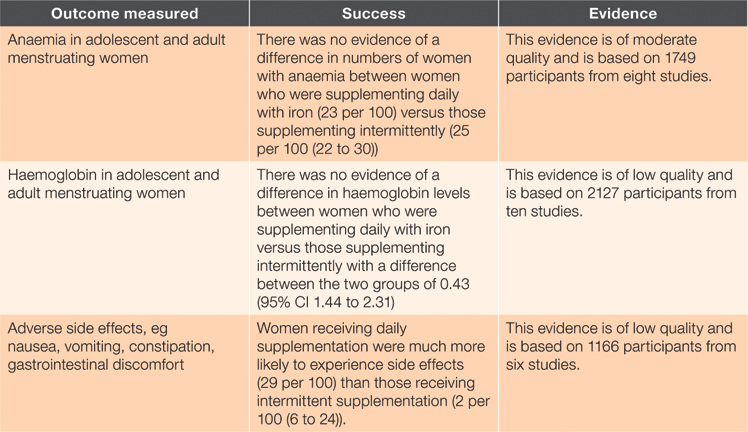Intermittent iron supplementation in women can reduce anaemia and has less side effects than daily supplementation
Vanessa Jordan 11 New Zealand Cochrane Fellow, University of Auckland, Auckland, New Zealand.
Email: v.jordan@auckland.ac.nz
Journal of Primary Health Care 11(1) 80-81 https://doi.org/10.1071/HC15941
Published: 3 April 2019
Journal Compilation © Royal New Zealand College of General Practitioners 2019.
This is an open access article licensed under a Creative Commons Attribution-NonCommercial-NoDerivatives 4.0 International License.
Cochrane review: Fernández-Gaxiola AC, De-Regil LM. Intermittent iron supplementation for reducing anaemia and its associated impairments in adolescent and adult menstruating women. Cochrane Database of Systematic Reviews 2019, Issue 1. Art. No. CD009218. doi:10.1002/14651858.CD009218.pub3
Background: Anaemia is a common problem in women of reproductive age and is estimated to affect ~7% of women in countries with high incomes and up to 40% in women in low to middle income countries depending on the levels of malaria, HIV and availability of clean drinking water and sanitation.1 Iron and folic acid supplementation is the recommended therapy for treating anaemia.2 However, patients tend to be non-compliant with this therapy due to the side effects experienced by taking iron supplementation.3
Clinical Bottom Line: This Cochrane review showed that women who were prescribed iron supplementation for three or less non-consecutive days per week had equivalent haemoglobin levels and numbers of women continuing to be affected by anaemia as women who were prescribed daily administration of iron supplements.4 However, women with intermittent supplementation were less likely to suffer from side effects such as constipation and gastrointestinal discomfort than those on daily supplementation.4

|
References
[1] Wirth JP, Woodruff BA, Engle-Stone R, et al. Predictors of anemia in women of reproductive age: Biomarkers Reflecting Inflammation and Nutritional Determinants of Anemia (BRINDA) project. Am J Clin Nutr 2017; 106 416S–27S.| 28615262PubMed |
[2] Clark SF. Iron deficiency anemia: diagnosis and management. Curr Opin Gastroenterol 2009; 25 122–8.
| Iron deficiency anemia: diagnosis and management.Crossref | GoogleScholarGoogle Scholar | 19262200PubMed |
[3] Mora JO. Iron supplementation: Overcoming technical and practical barriers. J Nutr 2002; 132 853S–5S.
| Iron supplementation: Overcoming technical and practical barriers.Crossref | GoogleScholarGoogle Scholar | 11925496PubMed |
[4] Fernández-Gaxiola AC, De-Regil LM. Intermittent iron supplementation for reducing anaemia and its associated impairments in adolescent and adult menstruating women. Cochrane Database Syst Rev 2019; 1 CD009218
| Intermittent iron supplementation for reducing anaemia and its associated impairments in adolescent and adult menstruating women.Crossref | GoogleScholarGoogle Scholar | 30699468PubMed |


